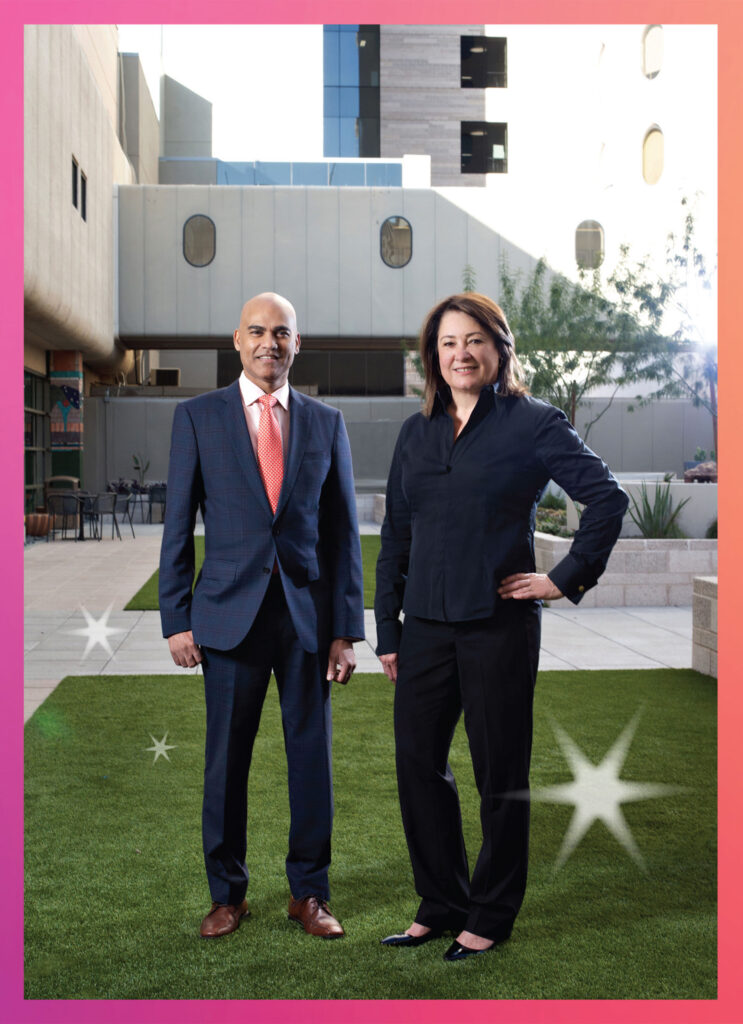KERIDWEN CORNELIUS March 19, 2020
SOME MEDICAL DISORDERS ARE SO RARE, SO FRIGHTFULLY EXOTIC, THERE MAY ONLY BE A HANDFUL OF DOCTORS IN THE ENTIRE VALLEY OF THE SUN QUALIFIED TO TREAT THEM. OR, SOMETIMES, A SINGLE DOCTOR. MEET THE ULTRA-SPECIALIZED SPECIALISTS WHO TAKE ON THE RAREST AILMENTS – OR TREAT COMMON CONDITIONS IN THE MOST UNCOMMON OF WAYS.
By the time Tatiana Richerds came to see Dr. Jamal Mourad, she had lost five pregnancies.
This time, she was carrying triplets. She suffered from cervical insufficiency, a rare condition that renders the cervix incapable of holding a fetus long-term. Without warning, usually between 16 and 24 weeks, the cervix opens, and the expectant mom miscarries.
During her fifth pregnancy, Richerds received the traditional, invasive treatment for the condition – transvaginal cerclage. Her first cerclage stitches didn’t hold, so a few weeks later, her doctor put in two more cerclages. It still didn’t work. She lost the pregnancy at 21 weeks.
As she entered the ninth week of her sixth pregnancy, Richerds was terrified. Her doctors referred her to Mourad, an OB-GYN at Banner University Medical Center Phoenix. Mourad is the only physician in Arizona who performs robotic-assisted transabdominal cerclage, a minimally invasive treatment for cervical insufficiency. He makes tiny incisions in the belly and wraps tape around the cervix, tightening it like purse strings. This can be done before or during pregnancy, and it allows expectant moms to carry their babies to nine months in more than 85 percent of cases.
But transabdominal cerclage is typically not recommended when a woman is carrying more than one fetus. So Mourad and his team scoured the medical literature, looking for any woman in the world who’d been treated with this method for a triplet pregnancy. They found nothing.
Reluctantly, Mourad told Richerds they couldn’t help her, because they didn’t know if the procedure would have any benefit. She burst into tears, knowing she would almost certainly lose three more babies. Then, Mourad recalls, she faced him with a determined look and said, “I am meant to be a mother. Please do this.”
He performed the procedure. And at 35 weeks, Richerds gave birth to triplets – one girl and two boys. “It’s just a blessing to have my babies here now,” Richerds says from her Mesa home, on the day before her triplets’ third birthday.
“On Mother’s Day, I met with the mom, the dad and the triplets,” Mourad says. “It was one of the most rewarding things I’ve ever done in my life.”
In desperate circumstances like these – when your baby is dying of a rare condition, or bacteria is eating your flesh, or dozens of doctors can’t diagnose you, or no one will give you a heart – you don’t need a regular doctor. You need a unicorn.
This is our ode to those rarities – the hyper-specialized heroes and heroines quietly saving lives, solving medical mysteries and working miracles.
Dr. John Breinholt does cardiac catheterizations on premature babies as tiny as a Coke bottle, with hearts the size of a raspberry. When he started performing procedures on micropreemies, his colleagues’ pulses quickened in fear. “I had my cath lab staff scared when these little kids would come down,” the interventional cardiologist says. “It takes a mindset change for people to understand what we are capable of doing.”
In November, Breinholt moved from Houston to become chief of cardiology for Phoenix Children’s Heart Center. He brings with him expertise in a mind-blowing method to cure a condition common in preemies: patent ductus arteriosus (PDA).
When we’re in Mom’s belly, Breinholt explains, all of us have a blood vessel called the ductus arteriosus. It allows the heart to pump blood throughout the fetus’ body and bypass the lungs, which aren’t needed inside the watery womb. Within a few days of birth, this vessel typically shrivels into a ligament. But in preemies, it often remains open. That’s PDA, and it potentially causes a range of respiratory and circulatory problems that can kill the littlest newborns.

Together, the Banner University doctors offer a rare combination of treatments: heart transplant and bariatric surgery. The aim is to put young, obese patients in heart failure on a fast track to bariatric sugery so they can quickly qualify for heart transplant.
Until recently, the only recourse for micropreemies with PDA was risky surgery. Then, about four years ago, a representative from a medical device company showed Breinholt a contraption designed for a different cardiovascular condition. He instantly knew it would be perfect for PDA. So he embarked on a new approach. He threads a catheter half the width of a red plastic coffee stirrer up through a vein in the infant’s leg. Then he inserts a device that looks like a miniscule metal mesh barbell into the PDA. The baby’s body grows tissue around the mesh, and the vessel closes.
Procedurally, this approach has a 100 percent success rate. Breinholt has performed it around 170 times – more than any physician in the country, except for one doctor in Tennessee. Now, Breinholt is coordinating with local medical centers to make the procedure available through Phoenix Children’s Hospital.
Another hyper-specialized doctor who’s pushing the envelope is Dr. Kevin Foster, director of the Arizona Burn Center. The Phoenix facility is the only burn center in the state and the largest west of the Mississippi River. Its multidisciplinary team works on the leading edge of treatments for burns and bizarre skin maladies. “We are constantly trying new things,” Foster says. “We are not satisfied with the status quo.”
For example, two years ago, Peoria resident Christin Lipinski was rushed to the trauma center with flu-like symptoms and severe pain under her armpit. Doctors did a biopsy and discovered the schoolteacher had a nasty case of necrotizing fasciitis – commonly known as flesh-eating bacteria.
This life-threatening torment is typically caused by a Streptococcus bacteria that’s harmlessly crawling on your skin right now. But occasionally – often when a person with a weakened immune system gets a cut or other injury – those microbes excrete toxins that annihilate tissues like tiny machine guns. Essentially, it’s high-speed gangrene.
To save Lipinski’s life, Foster and the other surgeons removed huge swaths of her skin, cutting down to the muscle. In a less severe case, he would patch up the wound with a piece of skin roughly the same size taken from elsewhere on the body. But Lipinski had already lost a third of her skin. With time running out,
Foster asked the FDA for special permission to use an experimental skin spray called ReCell.
With this invention, doctors can take a stamp-size piece of a patient’s skin and apply an enzyme that dissolves it into individual cells that can be misted over the injury like hair spray. The cells then grow into a new outer layer of skin. Foster had participated in studies to treat burns with ReCell, but as far as anyone knew, no one in the world had used it on someone with necrotizing fasciitis.
The FDA granted his request. Foster and his team quickly treated Lipinski with a method they developed called meshing. They sliced a patch of skin from her thigh and pierced it full of holes so it could stretch over the wound like fishnet stockings. Then they sprayed ReCell into the holes to reduce scarring. A week later, Lipinski’s ravaged tissues were 95
percent healed.
Foster is humble about his accomplishments and philosophical about the fulfilling aspects of his work. “Burn patients tend to have a reset of their priorities in life,” he muses. “Most of them end up recognizing that what they thought was important before, they no longer think is important. And they end up being different, better people.”
Continue reading this article https://www.phoenixmag.com/2020/03/19/unicorn-doctors/



